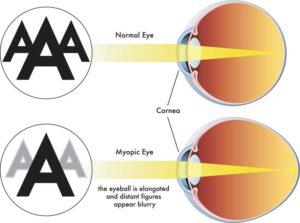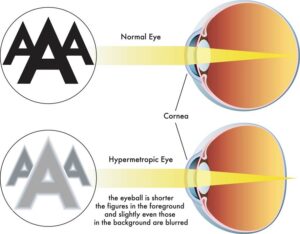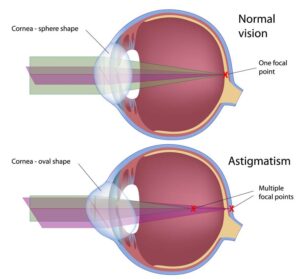Refractive errors occur when the eyes are unable to focus light exactly on the retina. They are optical defects that occur as a result of abnormalities in the length of the eyeball, the curvature of the cornea and/or the curvature of the lens.
As light rays enter our eyes, they are bent inwards (converged) by the cornea, then further bent by the crystalline lens which then focuses the light on the retina. When light is focused on the retina, the image formed is carried by the optic nerve to the brain where it gets interpreted. Any optical defect that causes light not to focus exactly on the retina will result in a refractive error.
Refractive errors are the most common cause of visual impairment. They are responsible for a large proportion of avoidable blindness all over the world. The World Health Organization (WHO) estimates that about 124 million people live with uncorrected refractive errors globally.
They are three major types of refractive errors namely; myopia (short-sightedness), hyperopia (long-sightedness) and astigmatism.
Types of Refractive Errors
Myopia (Short-sightedness)

In myopia, light rays focus in front of the retina. This occurs either because the eyeball is too long or the cornea is too curved.
In this condition, distant objects are blurred and near objects are clearer. This is the reason why people with myopia tend to move close to objects or bring materials close to their eyes. The nearer the object, the clearer it is for them.
Myopia can be inherited. It can also be a result of environmental factors. Some research studies suggest that excessive near work plays an active role in the development and progression of myopia. Therefore, people especially young children are advised to reduce the number of hours spent on near activities. Some other studies suggest that natural light help in the reduction and stabilisation of myopia. On this note, some eye care professionals recommend less screen time and more hours outdoors for people at risk of developing myopia.
Myopia can easily to be corrected with concave or minus lenses. High degree myopia, however, will require more care as it tends to be associated with complications such as cataracts, open angle glaucoma, retinal detachment, and posterior vitreous detachment.
Hyperopia (Long-sightedness)

In hyperopia, light rays focus behind the retina. This occurs either because the eyeball is too short or the cornea is too flat. Hence light rays entering the eyes do not converge adequately to bring their focus on the retina.
Generally, people with hyperopia experience blurring of vision at near but tend to see distant objects clearer. Some people with low degree hyperopia may see objects far and near clearly. This is because the lens in the eye easily compensates for it through accommodation. Excessive accommodation, however, can result in eye strain and headache.
Mild hyperopia is normal in babies and small children and is usually not a problem. It resolves between the ages of 3 and 5 years. Significant hyperopia, on the other hand, is problematic and can be corrected with convex or plus lenses.
Astigmatism

In astigmatism, light rays fail to come to a single focus on the retina. This occurs when the cornea has an unequal curvature and light rays entering the eyes form multiple focal points either in front of the retina, behind it or both. Since there are multiple focal points, vision is blurred and the object may appear distorted or tilted. People with astigmatism may squint and also experience headaches, brow aches and eye irritations.
Astigmatism can come in different forms. The common ones are:
- Simple astigmatism: In simple astigmatism, one principal focus of light rays is on the retina and another principal focus is either in front of the retina (simple myopic astigmatism) or behind the retina (simple hyperopic astigmatism)
- Compound astigmatism: In compound astigmatism, the two principal foci of light rays are at different locations in front of the retina (compound myopic astigmatism) or behind the retina (compound hyperopic astigmatism)
- Mixed astigmatism: In mixed astigmatism, one principal focus of light rays is in front of the retina and the other principal focus is behind the retina.
Astigmatism may be associated with other eye conditions such as keratoconus (conic cornea) and keratoglobus, nystagmus and ocular surgeries. It is corrected using cylindrical lenses
Diagnosis and Treatment of Refractive Errors
Refractive errors can be corrected using eyeglasses, contact lenses or through surgeries (such as laser surgery or intraocular lens insertion).
Before recommending one of these options, your eye doctor will exam you do determine the type of refractive error you have as well as the power of the lens that will correct your vision. The components of an eye exam that help determine these are visual acuity test and refraction. The results of these tests will be evaluated together with other information gathered during your eye examination to determine the best corrective option for you.
Eyeglasses
Prescription eyeglasses are the simplest, safest and most common means of correcting refractive errors. They are relatively cheap and rarely cause complications. Depending on the type of refractive error, lenses prescribed could be spherical, cylindrical or a combination of both.
Spherical lenses have equal refractive power all around. They are used to bring light to focus on the retina. They include:
- Concave or minus lenses: These lenses diverge light rays as they pass through them into the eyes; such that rays that would normally focus in front of the retina move farther back to focus on the retina. Therefore, they are used to correct myopia.
- Convex or plus lenses: These lenses converge light rays as they pass through them into the eyes; such that rays that would normally focus behind the retina are brought forward to focus on the retina. Therefore, they are used to correct hyperopia.
Cylindrical lenses have two refractive powers, one on each meridian of the lens. Light rays passing through a cylindrical lens are refracted at the two meridians at different angles such that rays which would normally form multiple foci points are brought to one focal point on the retina. Therefore, they are used to correct astigmatism.
Contact Lenses
These are medical devices that are placed directly on the cornea and the sclera for the correction of refractive errors. Contact lenses could be spherical, cylindrical or combination of both.
Laser Refractive Surgeries
Laser refractive surgeries are laser procedures used to correct refractive errors. The surgery reshapes the cornea to enable it converge light better so that light rays entering the eye can focus better on the retina.
Intraocular Lens
An intraocular lens (IOL) is a special plastic lens normally used to replace the natural lens in the eye after cataract extraction. It is now being used by some eye surgeons to correct refractive errors. In this case, an eye surgeon would either remove the natural lens and replace it with an intraocular lens or place the intraocular lens over the natural lens so that the accommodative function of the natural lens is retained.